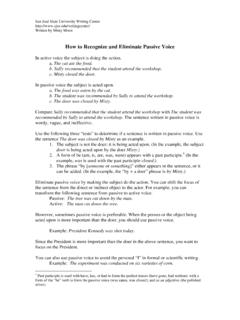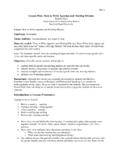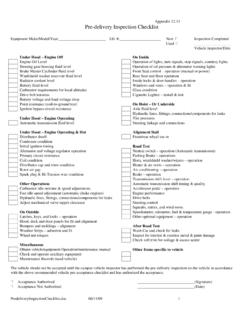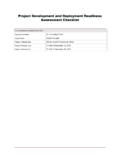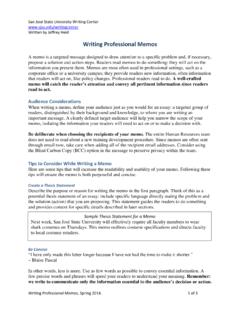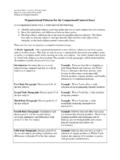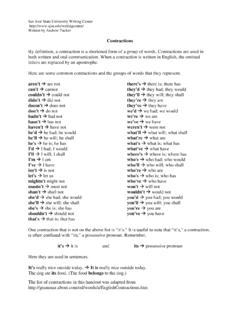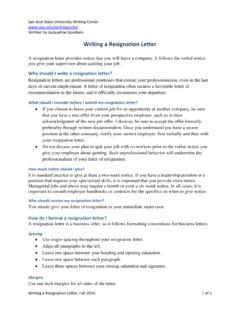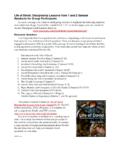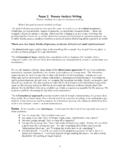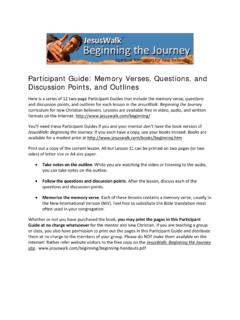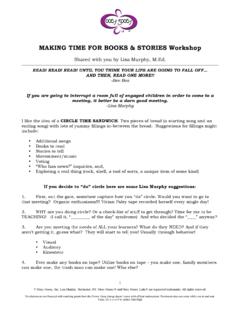Transcription of Personal Narrative Essays - San Jose State University
1 San Jos State University Writing Center Written by Jacqueline Goodwin Personal Narrative Essays , Spring 2015. 1 of 5 Personal Narrative Essays This handout will help you begin your Personal Narrative essay assignment with key points and questions to prompt story development. What is a Personal Narrative essay? A Personal Narrative essay is a story you choose to share with readers, for it communicates your understanding of yourself, others, and/or society. As people, we remember stories, so your Personal Narrative essay is a way you can transform an ordinary experience into meaningful commentary that is applicable to a broad audience.
2 What questions can I consider to help me convey my story effectively? A Personal Narrative essay uses the components of a story: introduction, plot, characters, setting, and conflict. It also uses the components of argument, thesis, and conclusion. In a Personal Narrative essay, we tell our readers a story to make a larger argument. Focusing the readers attention on significant, detailed scenes, we develop our argument persuasively through effective storytelling. Conflict and Thesis: Finding the Meaning of Your Story Because the Personal Narrative essay is an argument, providing a thesis will help your readers understand the purpose of your story.
3 An effective thesis in a Narrative often responds directly to or reflects on a source of conflict, so the first step in developing a Personal Narrative essay is usually to define the conflict at the heart of your story. Consider the following questions about conflict as they relate to your Personal Narrative : Is your conflict internal, taking place inside you as you struggle to make sense of competing ideas about yourself, others, social norms, and so on? Who or what challenged preconceived notions you have had? Is your conflict external, pitting you against circumstances or others involved in an experience with you?
4 Is your conflict in response to a stereotype or mentality society holds about some part of your identity? Your story helps readers reflect on the negotiation of conflict, which generates meaning. Your thesis articulates that meaning succinctly. Sometimes this meaning remains implicit in the Narrative the details themselves powerful enough to evoke understanding among your readers. With an understanding of your conflict, consider the following questions for your thesis: What lesson did you learn from the resolution of your conflict that your readers can identify with? How has your perspective changed in a way that relates to your specific audience?
5 Personal Narrative Essays , Spring 2015. 2 of 5 What did this conflict communicate to you about yourself, family, and/or society; how might you communicate this learning to your audience? Background and Setting: Developing the Context of Time and Place Consider the following questions as you develop the setting of your Narrative . What is the event you want to share? Where did this event take place? When did this event occur? How do the details of time and place develop the context your readers need to understand the meaning of the story? What initial expectations or mentality do these details help viewers to establish that will be changed, developed, or affirmed as your story progresses?
6 Plot: Analyzing Cause and Effect Consider the following questions as you develop the plot of your Narrative . What important events led to this event? What action happened immediately before the event? What action happened after the event? What changed as a result of the event? How has this event impacted you directly or indirectly? Characters: Recognizing the Human Dimension of Your Story Consider the following questions as you develop the characters in your Narrative . Who was involved in this event? What is the relationship between you and these other individuals?
7 Why are these individuals significant to your Narrative ? How might their views present a source of conflict in the Narrative ? Who is static in the story, and who is dynamic? That is, who does not change, and who does change? Because humans are not one-dimensional, how might you offer multiple perspectives as a basis for why characters chose the action they did? Did this story involve a dialogue of points of view among or between characters? Climax: Isolating the Central Meaning Consider the following questions as you develop the climax of your Narrative . At what point in your story did your understanding of your conflict change?
8 What meaning is revealed in the moment of truth or the moment of revelation or recognition? Personal Narrative Essays , Spring 2015. 3 of 5 Conclusion/Resolution: Providing Closure for the Narrative , a Conclusion to the Argument Consider the following questions as you develop the conclusion to your Narrative . How was the conflict resolved, or to what extent? How can you illustrate relief from or resolution of the tension caused by the conflict? Why might the reader believe this conflict will or will not pose a problem in the future? What story-telling tools will I need to tell my story?
9 The questions above have helped you to generate the content of your essay and focus its meaning. Now it is time to tell the story. Two important story-telling tools are (1) concrete and figurative word choice and (2) verb tense. Concrete and Figurative Word Choice By including sensory details and figurative language, you can help your reader appreciate your experience and understand your thoughts and actions. Sometimes stories are so detailed that readers are carried along to the conclusion without any explicit statement of the main argument: in such cases the details have been powerful enough to imply the main argument.
10 Please refer to our Concrete Language Homegrown Handout for more information (available at ). Verb Tenses in a Narrative Essay Storytelling engages readers in reading actions as they develop through time. Telling time is critical in reading a story. To discern which verb tense or tenses to use in your Narrative , please reference our Verb Tenses: Telling Time Homegrown Handout (available at ). Activity: Analyzing a Personal Narrative Essay Read the introduction, climax, and conclusion of Langston Hughes Salvation a chapter from his autobiography, The Big Sea and answer the questions that correspond to each excerpt.


